Overview
Data integration is crucial for organizations aiming to consolidate data from various sources into a cohesive dataset for analysis. In contrast, application integration emphasizes real-time connectivity among applications, facilitating seamless information exchange. Organizations face a pivotal choice between these strategies based on their specific goals.
How can they determine which approach best serves their needs?
- Data integration significantly enhances decision-making by providing comprehensive insights.
- Application integration boosts operational efficiency, enabling swift responses to ever-changing demands.
By recognizing these distinctions, organizations can strategically leverage the benefits of each integration type to optimize their operations and drive success.
Introduction
In the dynamic landscape of modern business, the ability to effectively integrate data and applications is paramount for organizations striving to maintain a competitive edge. Companies face the complexities of disparate systems and an ever-increasing volume of data. Understanding the nuances between data integration and application integration is essential.
While data integration focuses on consolidating information for analysis and reporting, application integration emphasizes real-time connectivity and workflow automation across various software platforms.
This comprehensive exploration delves into the distinct methodologies, tools, and strategies that underpin these integration types, shedding light on their respective benefits and challenges.
With the right approach, organizations can unlock the full potential of their data and applications. Ultimately, this drives informed decision-making and operational efficiency in an increasingly interconnected world.
Understanding Data Integration and Application Integration
The combination of information is the procedure of merging details from different origins to produce a unified perspective, primarily for examination or reporting. This typically involves the extraction, transformation, and loading (ETL) of content into a centralized repository, such as a data warehouse. In contrast, software unification focuses on linking diverse programs to enable smooth cooperation.
This can encompass real-time information exchange and workflow automation, empowering applications to share insights and initiate processes across various systems.
Both data integration and application integration are crucial for enhancing operational efficiency, yet they utilize different methodologies and technologies. Entities that efficiently evaluate their existing information sources—both organized and unorganized—can significantly enhance their unification processes. A thorough assessment of these information landscapes results in informed decision-making and improved utility, aligning incorporation strategies with overarching business goals.
This is especially vital as entities navigate the complexities of merging legacy systems with contemporary applications.
Recent statistics underscore the increasing importance of information amalgamation processes; by 2025, the number of IoT connections is anticipated to reach 20.3 billion, highlighting the necessity for robust amalgamation solutions. Furthermore, information governance has emerged as a top priority for 60% of leaders in the field, with the market valued at $3.02 billion in 2022. This emphasizes the urgency for entities to manage the rapid increase of data effectively, as insufficient governance can lead to disjointed data environments that obstruct unification efforts.
Industry leaders stress the essential role of data unification in contemporary business operations. As Gustavo Estrada noted, entities benefit from solutions that simplify complex projects and deliver results within desired time frames and budget constraints. This sentiment resonates across industries, particularly in banking, where the integration of legacy systems with contemporary software is crucial for maintaining a competitive edge.
Avato’s hybrid unification platform exemplifies this capability, allowing entities to maximize and extend the value of their legacy systems while simplifying complex connections and significantly lowering expenses. The platform also offers real-time surveillance and notifications regarding system performance, ensuring that businesses can respond promptly to any issues that arise.
As we approach 2025, trends in data integration and application integration continue to evolve. The emphasis on real-time information access and the automation of workflows is becoming increasingly essential for organizations aiming to enhance their operational capabilities. By regularly reassessing collaborative solutions, businesses can keep pace with technological advancements and market demands, ensuring they remain agile and responsive in a rapidly changing landscape.
Avato’s commitment to architecting the technology foundation required to power rich, connected customer experiences is essential in this journey.
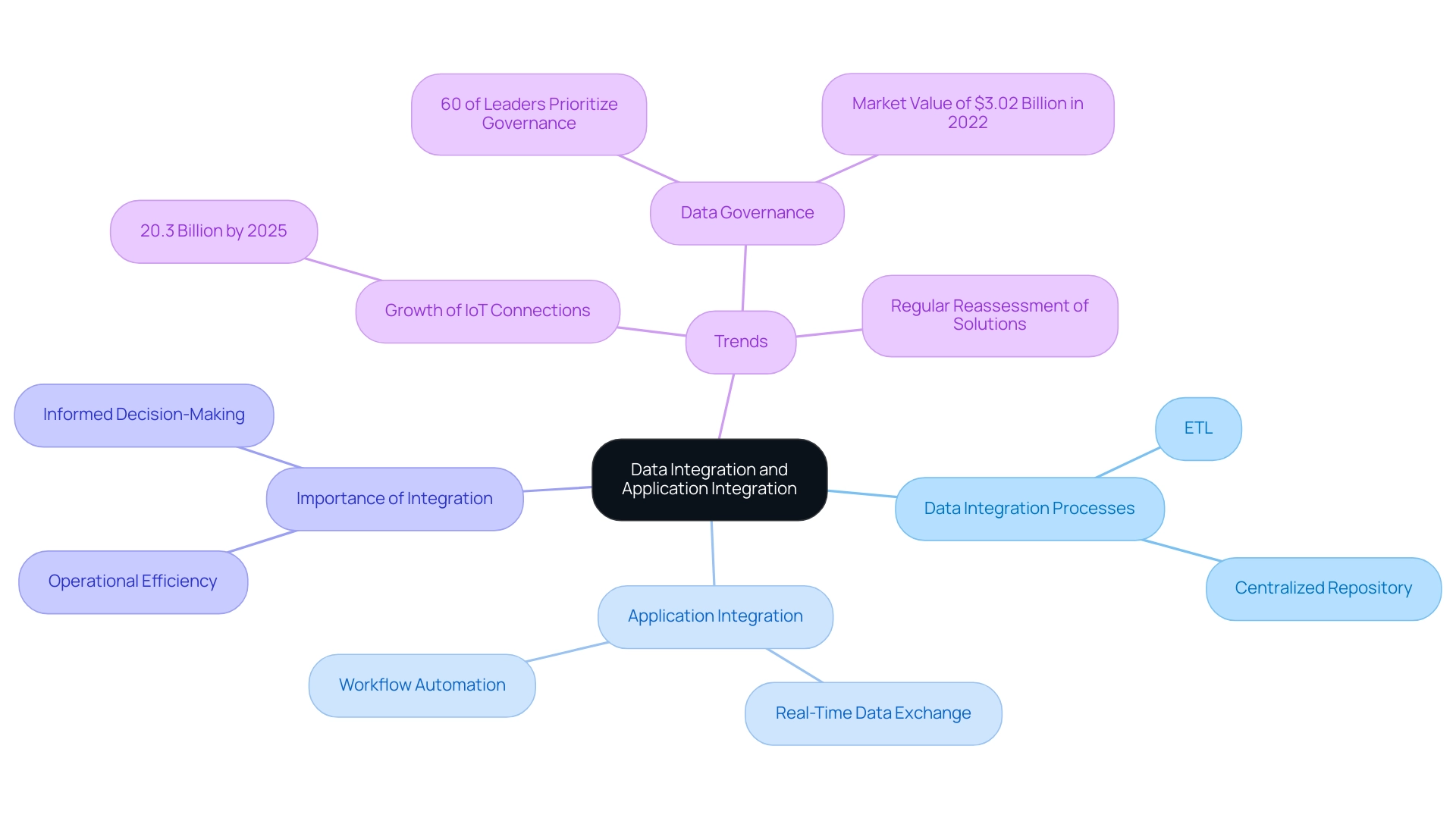
Key Differences Between Data Integration and Application Integration
The essential difference between data integration and application integration lies in their respective focuses and approaches. Information unification is centered on merging data from various origins into a cohesive dataset, often employing batch processing methods. This approach can be slower, as it typically involves managing information at rest, potentially leading to delays in accessing the most current details.
In contrast, application unification prioritizes real-time connectivity among applications, facilitating instant information exchange and process automation. This dynamic approach not only accelerates operations but also enhances the seamless functioning of business processes across diverse software systems.
Furthermore, information amalgamation places a strong emphasis on quality and consistency, ensuring that the consolidated details are accurate and trustworthy. This is especially vital in industries such as banking and healthcare, where information integrity is paramount. Conversely, application unification focuses on operational efficiency and enhancing user experience, enabling entities to react quickly to evolving demands and optimize workflows.
Statistics reveal that organizations with efficient information unification strategies can significantly improve their operational capabilities. A study titled ‘Impact of Poor Coordination on Supply Chain Companies’ highlighted that 25% of supply chain firms could incur losses exceeding $500,000 annually due to poor coordination practices, underscoring the financial impact of inadequate data management. Furthermore, 85% of surveyed companies acknowledged experiencing financial setbacks stemming from unification issues, emphasizing the critical need for robust unification solutions.
In the context of financial services, the differences between data integration and application integration become even more pronounced. Information consolidation might entail combining customer data from different sources to create detailed profiles, while application unification allows real-time transactions and updates across banking systems, improving customer service and operational responsiveness. With the rise of generative AI, financial institutions are increasingly leveraging this technology to enhance customer experience, as evidenced by a 60% increase in its use for developing sophisticated chatbots and virtual assistants.
As Gustavo Estrada from BC Provincial Health Services Authority noted, Avato streamlines complex projects and achieves results within preferred time frames and budget limits, demonstrating the advantages of effective collaboration in sectors such as banking and healthcare. Moreover, Avato’s hybrid connection platform, which supports 12 levels of interface maturity, accelerates secure system unification, enabling enterprises to act on information while ensuring operational visibility and problem resolution. As entities navigate the complexities of digital transformation, understanding these distinctions is essential for utilizing the right unification strategies to achieve their business objectives.
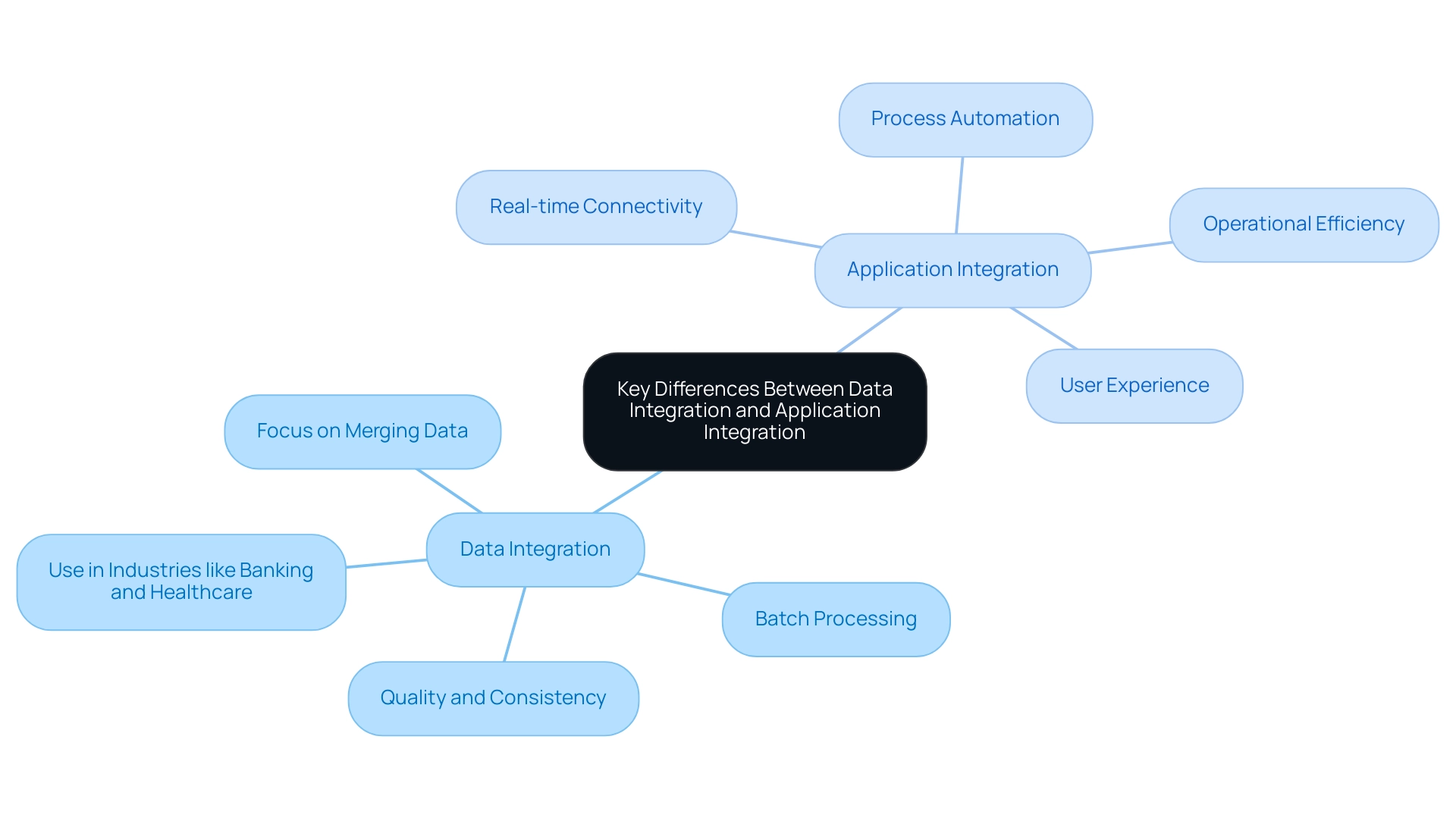
Tools and Techniques for Effective Integration
In the realm of information unification, grasping the distinctions between data integration and application integration is paramount. Leading tools such as Informatica, Talend, and Microsoft Azure Data Factory exemplify this. These platforms optimize ETL (Extract, Transform, Load) processes, enabling organizations to effectively extract data from diverse sources, transform it into a usable format, and load it into data warehouses. Notably, Informatica Data Services has gained significant traction, with projections indicating that over 354 companies will adopt it as their preferred information unification tool by 2025, underscoring its growing importance in the industry.
Conversely, software unification frequently employs middleware solutions, which accentuate the differences between data integration and application integration. Tools like MuleSoft, Dell Boomi, and Apache Camel facilitate seamless interactions among various applications, allowing for real-time information sharing. Techniques such as API management, event-driven architecture, and service-oriented architecture (SOA) are vital for effective application unification, especially when evaluating data integration against application integration to ensure diverse systems collaborate efficiently.
A recent study by Oxylabs.io revealed that 43% of retailers leverage information unification to enhance market trend predictions, while others focus on consumer demand forecasting and refining pricing strategies. This statistic highlights the crucial role of information unification in empowering informed decision-making across various sectors.
Avato’s hybrid unification platform stands ready to assist organizations in harnessing information unification for these goals, ensuring rapid responses to market fluctuations.
One of the standout features of Avato’s platform is its integration of XSLT for XML data transformation. XSLT simplifies the XML transformation process and mitigates the complexity and potential errors associated with traditional programming methodologies. By utilizing schemas, Avato enhances data management and coordination, resulting in substantial cost savings and improved accuracy in data handling.
As organizations increasingly adopt DataOps and FinOps support tools, the management of data pipelines and control of cloud costs have been streamlined, reflecting current best practices in the field. Continuous monitoring and analytics are crucial for maximizing system performance, ensuring operational continuity, and adapting to evolving conditions. Avato plays a pivotal role in this landscape by guaranteeing 24/7 uptime for critical connections, essential for maintaining operational continuity.
The consolidation landscape is evolving, making it vital for IT managers to stay informed about these trends to optimize their consolidation strategies. As Gustavo Estrada noted, Avato simplifies complex projects, delivering results within desired time frames and budget constraints, establishing itself as a valuable asset in any toolkit.
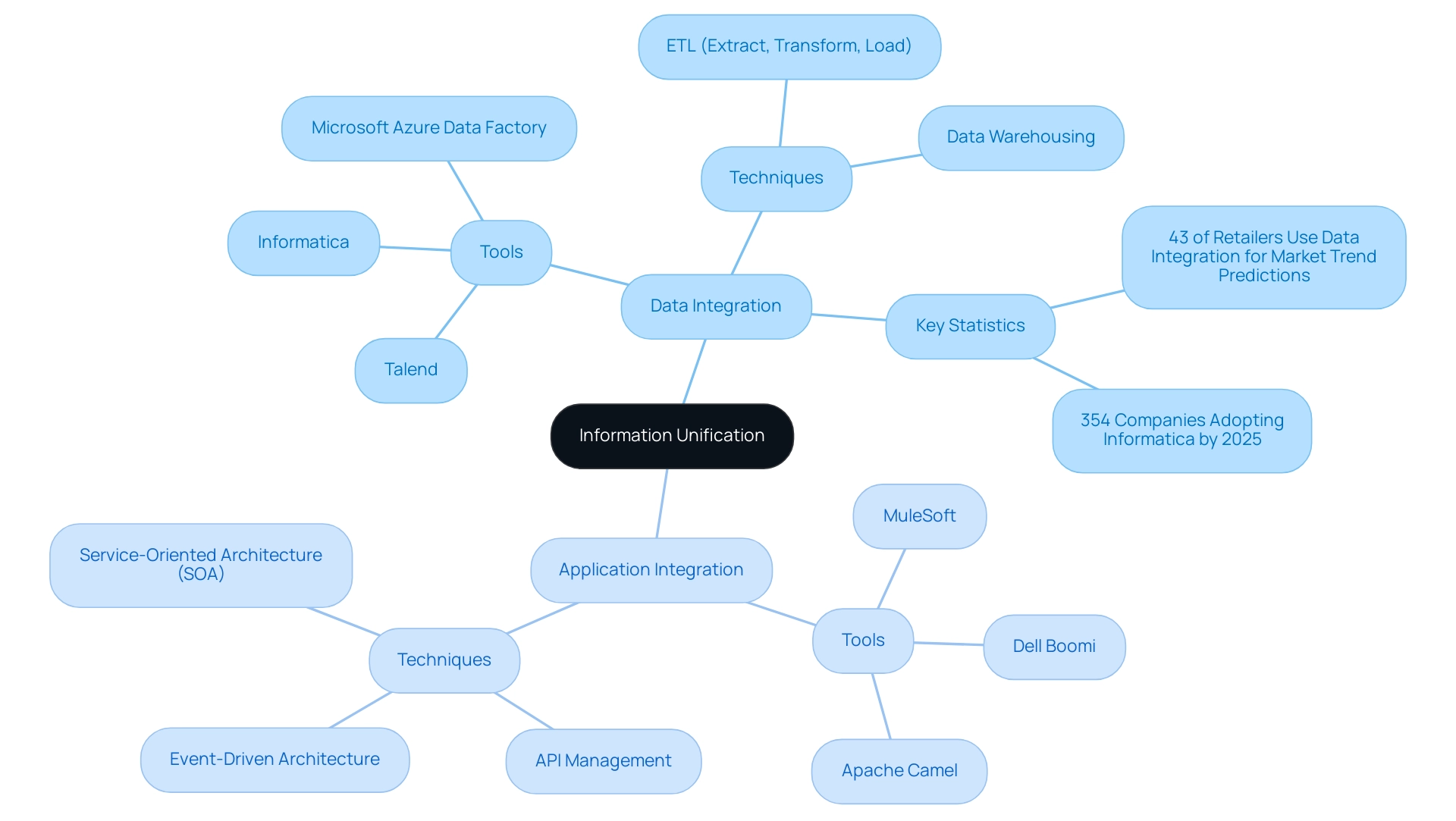
Benefits of Data Integration vs. Application Integration
Combining information offers numerous advantages, including enhanced quality of information, improved decision-making capabilities, and a cohesive perspective on organizational data. By consolidating insights from diverse sources, businesses can uncover deeper understandings, leading to more informed decisions. For instance, Baublebar, an e-commerce jewelry retailer, leverages extensive analytics to monitor customer preferences and align them with social media trends, empowering them to make strategic decisions about their product offerings.
This information-driven approach not only sustains their competitiveness in the fast fashion industry but also illustrates how effective information amalgamation can drive business success.
Furthermore, statistics from Google’s Project Oxygen reveal that effective information amalgamation significantly boosts managerial favorability scores, which increased from 83 percent to 88 percent. This highlights the profound influence of information-driven decision-making on leadership effectiveness.
Conversely, application amalgamation markedly enhances operational efficiency by streamlining workflows, minimizing manual data entry, and facilitating real-time information access across various applications. This synergy results in quicker response times and improved customer experiences. For example, Red Roof Inn utilized data on flight cancellations and weather conditions to launch a targeted marketing campaign, resulting in a 10% increase in turnover.
Such real-world examples demonstrate how software unification can transform operational processes and enhance overall business agility. As Tim Stobierski notes, operational effectiveness is crucial for entities striving to excel in competitive markets.
Both information and application unification are essential in promoting corporate agility. However, the choice between data integration and application integration hinges on whether the primary objective is information analysis or operational effectiveness. As organizations aim to become more data-centric, a gradual strategy involving benchmarking and comprehensive documentation can pave the way for success, ensuring they harness the full potential of their unification tactics. Avato’s dedicated hybrid unification platform stands out in this landscape, streamlining the connection of diverse systems and enhancing business value, ultimately enabling companies to future-proof their operations through seamless information and system unification.
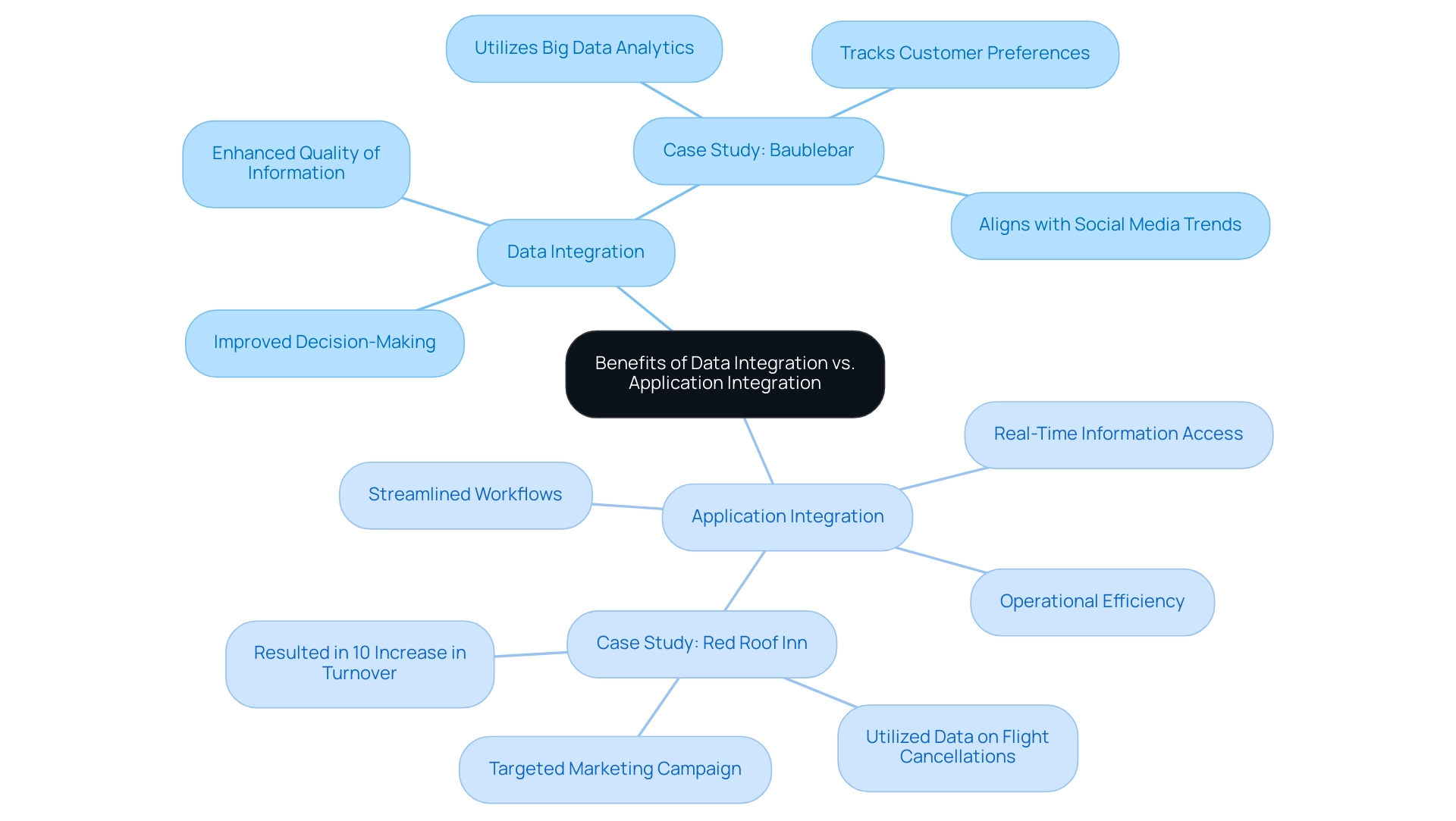
Use Cases: When to Choose Data Integration or Application Integration
The amalgamation of information is essential in scenarios where organizations must assess vast amounts of insights from diverse sources, particularly in business intelligence and reporting contexts. For instance, a retail business may leverage information merging to consolidate sales figures from various channels, enabling a comprehensive evaluation of overall performance. This approach not only enhances visibility into sales trends but also supports informed decision-making based on accurate, aggregated data.
Conversely, system unification is critical in environments where immediate information exchange is crucial, such as customer relationship management (CRM) platforms. A financial organization, for example, might implement application unification to guarantee that customer information is consistently updated across multiple applications. This capability significantly boosts customer service and operational efficiency, allowing staff to access the most current information without delays.
The importance of these unification strategies is underscored by the fact that 60% of information leaders prioritize governance as the volume of data continues to escalate, with the market valued at $3.02 billion in 2022. Despite advancements in governance frameworks, 66% of organizations still encounter breaches, highlighting the ongoing challenges in managing security and usability. As the social business intelligence industry is projected to reach $25,886.8 million in 2025, the demand for effective information unification solutions becomes increasingly vital for companies aiming to maintain a competitive edge.
In the retail sector, the unification of information is not merely advantageous; it is evolving into a necessity for those striving to thrive in a competitive landscape. As Dmytro Tymofiiev, Delivery Manager at SPD Technology, asserts, “The reality is that information science in retail is no longer an option for those who want to stay competitive—it’s a necessity.” Experts suggest that organizations should carefully evaluate when to implement data integration versus application integration, taking into account their specific operational needs and objectives.
By understanding the distinct use cases for data integration versus application integration, companies can more effectively navigate the complexities of combining and maximize the full potential of their information and applications.
Moreover, Avato, named after the Hungarian term for “of dedication,” leads in innovative hybrid unification solutions that empower businesses to secure their operations for the future through seamless information and system unification. Founded by a group of committed enterprise architects, Avato is dedicated to simplifying intricate connectivity challenges. By providing a reliable, future-ready technology framework, Avato enables organizations to adapt to evolving requirements, addressing the challenges posed by information governance and security.
This ensures that businesses remain competitive in an ever-changing market, leveraging Avato’s expertise to unlock isolated assets and generate significant business value.
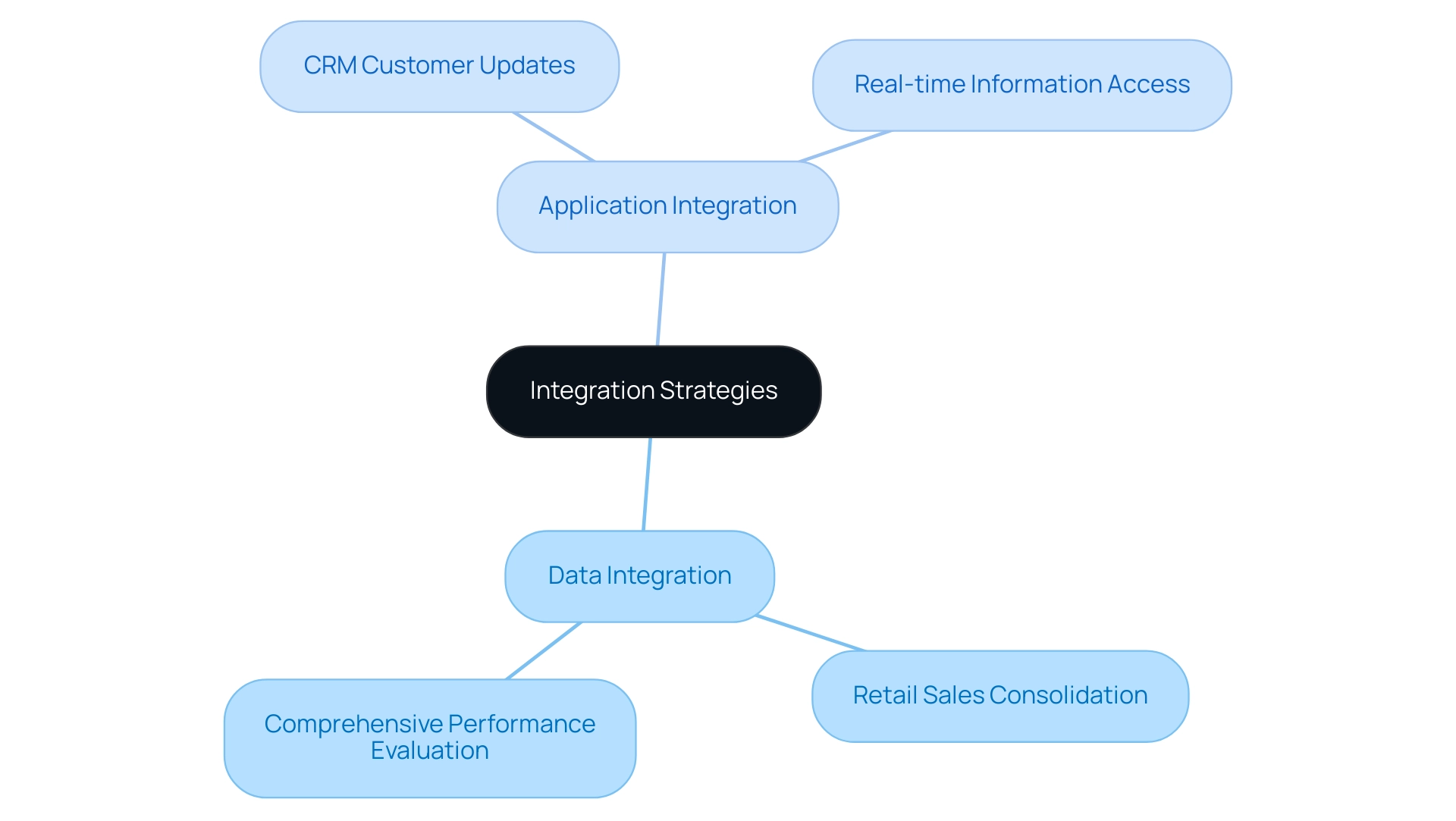
Challenges in Data and Application Integration
Both data integration and application integration present distinct challenges that organizations must navigate to achieve seamless connectivity. Information integration often grapples with issues such as quality, the existence of silos, and the complexities involved in merging disparate sources. Ensuring that information remains accurate, consistent, and up-to-date is a persistent struggle for many enterprises.
In fact, a significant 62% of employees have unauthorized access to information, underscoring the critical need for robust governance policies to manage these risks effectively. As industry leaders emphasize, establishing clear data governance policies is crucial for effective management, particularly in light of these security concerns. Conversely, in the realm of data integration versus application integration, software connection faces its own set of hurdles, including the management of API changes, maintaining security across interconnected systems, and ensuring optimal performance during peak loads.
Organizations frequently find it challenging to align their business processes with the technical capabilities of integrated applications, which can significantly impede the success of their collaboration initiatives. A notable case study reveals that 25% of executives indicate their CRM systems lack sufficient connections, a deficiency that can negatively impact client satisfaction, as many clients specifically look for strong connections during assessments.
Expert insights highlight the necessity of addressing these issues directly. For instance, Gustavo Estrada has praised Avato for its ability to simplify complex projects and deliver results within desired time frames and budget constraints. Avato’s Hybrid Integration Platform streamlines digital transformation through structured requirements management, enabling entities to convert unstructured information—often found in paragraphs of text, meeting notes, and whiteboard screenshots—into a clear hierarchical requirements model.
This capability is particularly vital for legacy system modernization in regulated industries, as it allows Banking IT Managers to ensure that all requirements are clearly defined and testable. As organizations continue to modernize their unification strategies in 2025, understanding these challenges and implementing effective solutions will be crucial for maintaining a competitive edge. Furthermore, a recent initiative at Statistics Canada seeks to generate estimates of design variance for record linkage error rates, highlighting ongoing coordination challenges and the need for innovative solutions.
Obtain your copy now to discover how Avato can transform your business unification efforts.
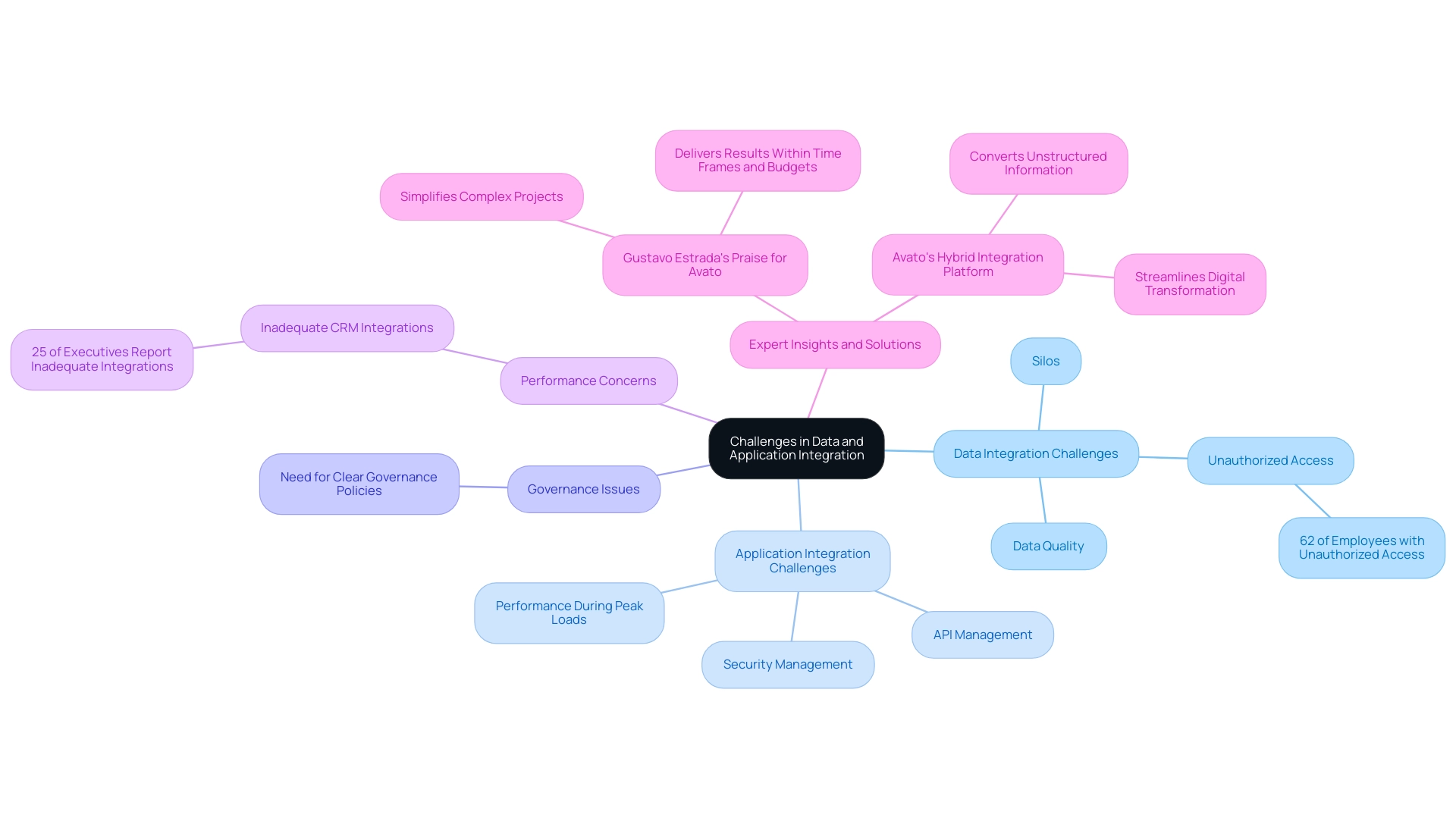
Choosing the Right Integration Strategy for Your Business
Choosing the suitable unification approach—data integration versus application integration—necessitates a comprehensive understanding of a company’s distinct business goals, the characteristics of its information, and the operational requirements of its applications. For organizations aiming to enhance their information analysis and reporting capabilities, merging often emerges as the more advantageous option. This approach emphasizes the consolidation and analysis of static information, making it particularly effective for generating insights from historical context.
Conversely, if the primary objective is to improve operational efficiency and enable real-time information exchange, application unification becomes the more fitting choice. This strategy focuses on the seamless flow of operational data, allowing entities to respond swiftly to changing conditions and demands. Notably, Avato guarantees 24/7 uptime for critical connections, underscoring the reliability of strategies that maintain operational efficiency and enhance business value.
When assessing merging strategies, it is crucial for organizations to evaluate their existing technology stack and the complexity of their merging requirements. Considerations such as the time required to onboard new supply chain partners—often hindered by inadequate application compatibility and legacy system issues—should not be overlooked. Recent trends indicate that enterprises are increasingly prioritizing strategies that not only meet immediate operational needs but also align with long-term digital transformation goals.
Practical examples underscore the importance of evaluating incorporation needs. For instance, organizations in the banking sector have recognized that selecting the appropriate unification strategy can significantly impact their capacity to innovate and remain competitive. A case study titled “Data Integration vs Application Integration” illustrates that while application integration is essential for evolving real-time data needs, data integration plays a crucial role in uniting and analyzing static data.
Gustavo Estrada, a client, noted Avato’s ability to streamline complex projects and deliver results within preferred timelines and budget constraints, enhancing the credibility of their effectiveness. Ultimately, the decision should be guided by a careful evaluation of unique business requirements, available resources, and the desired outcomes of the initiative. As organizations navigate the complexities of unification in 2025, aligning their strategies with both current operational demands and future growth objectives will be essential for achieving success.
Moreover, Avato’s commitment to delivering value through speed, security, and simplicity in system integration sets its offerings apart from competitors, emphasizing the significance of these elements in strategy selection.
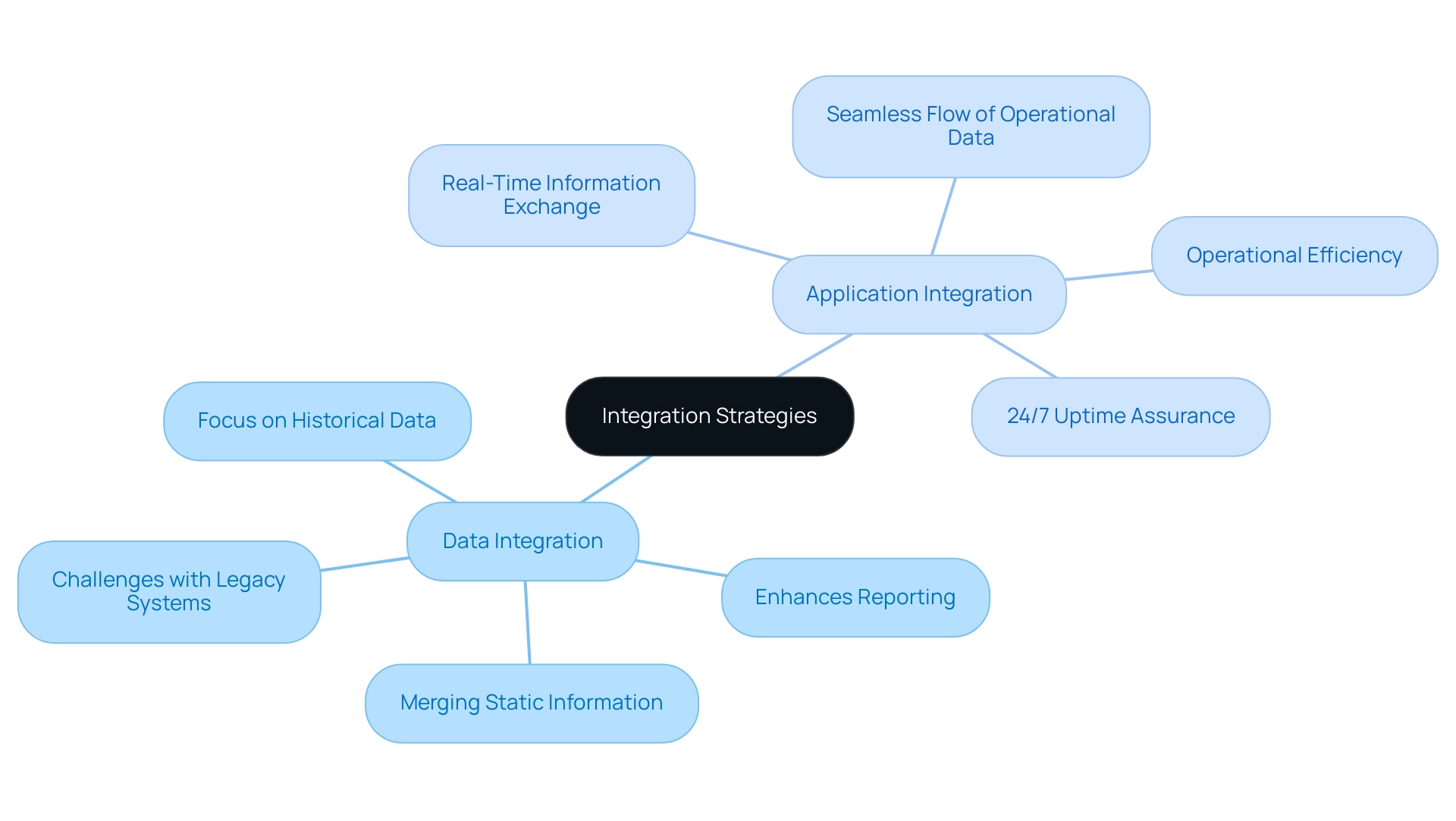
Conclusion: Navigating the Integration Landscape
In today’s competitive landscape, both information unification and software unification stand as critical pillars of modern business operations, each uniquely contributing to enhanced efficiency and accessibility of information. Data unification focuses on consolidating disparate data sources into a cohesive view, empowering organizations to harness insights for informed decision-making. Conversely, application coordination stresses the importance of seamless interaction among various software applications, ensuring they operate in harmony to streamline processes.
As companies navigate this evolving landscape, evaluating specific needs, challenges, and objectives becomes imperative. Current trends indicate that organizations prioritizing unification strategies are better positioned to adapt to shifting market demands. For example, companies leveraging robust connection frameworks can experience up to 40% lower churn rates, as evidenced by Typeform users who utilize Zapier connections.
Furthermore, Avato guarantees 24/7 uptime for essential connections and supports 12 levels of interface maturity, underscoring the reliability and sophistication that organizations can anticipate from effective connection strategies.
Real-world examples further validate the efficacy of these strategies. Organizations that have successfully integrated their systems report enhanced operational capabilities and improved customer experiences. A notable case study involves Avato’s collaboration with Coast Capital, where the hybrid unification solution enabled a seamless transition of their telephone banking and contact center telephony system with only a 63-second outage.
This level of reliability and speed is paramount for financial institutions striving to modernize operations without disrupting service.
Expert insights highlight the importance of unification strategies in data-driven environments. Industry leaders assert that effective unification not only streamlines operations but also positions businesses to seize emerging opportunities. As Tony Leblanc from the Provincial Health Services Authority aptly states, “Good team. Good people to work with. Extremely professional. Extremely knowledgeable.”
This sentiment reflects the caliber of support and expertise that Avato provides to its clients.
In conclusion, understanding the distinct advantages and challenges of both data integration and application integration is crucial for organizations aiming to thrive in an increasingly data-driven world. By adopting the right integration strategy, such as Avato’s hybrid integration platform, businesses can significantly enhance operational efficiency, reduce costs, and improve customer satisfaction, thereby securing a competitive edge.
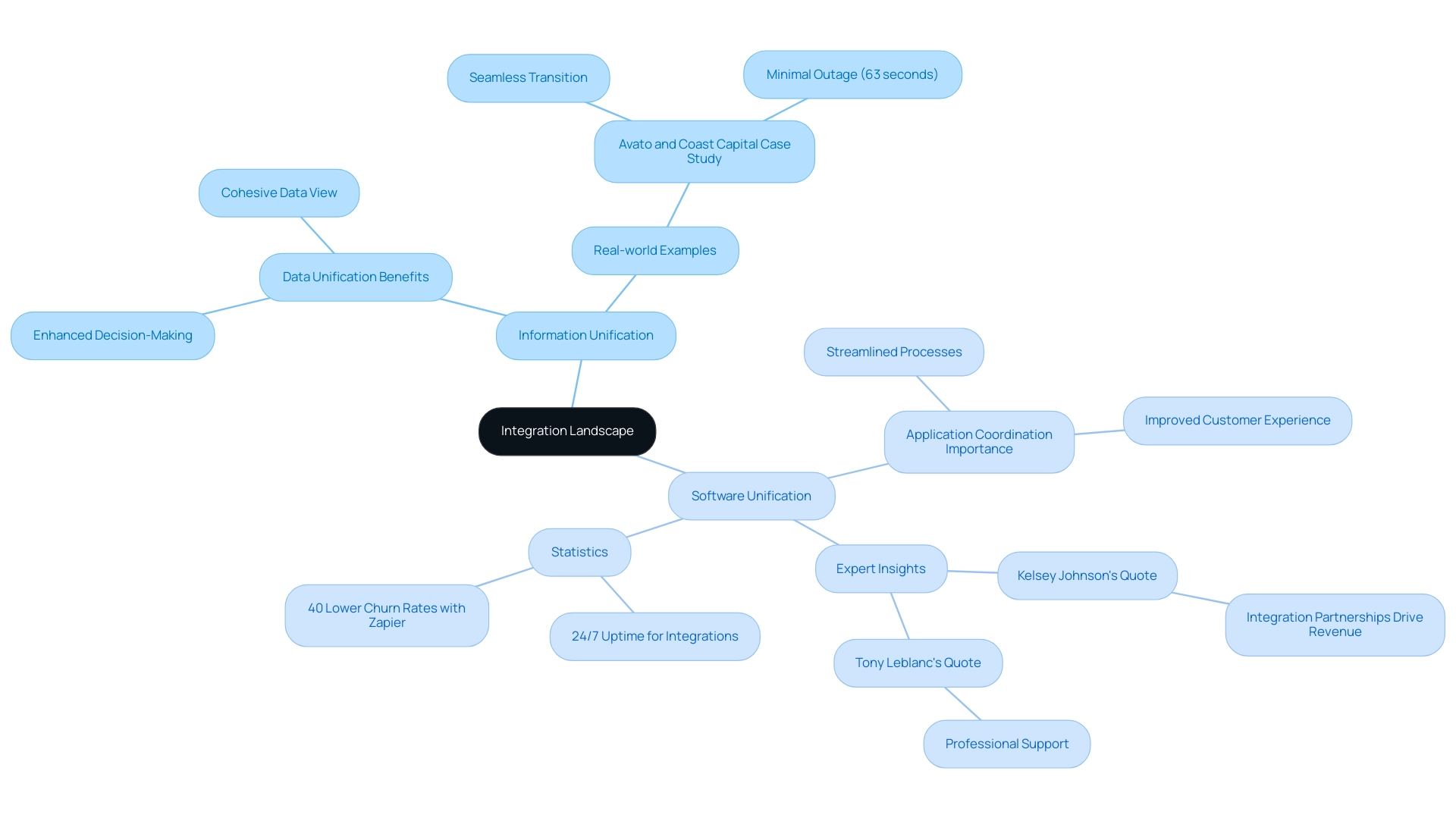
Conclusion
In today’s fast-paced business environment, both data integration and application integration are essential for organizations aiming to thrive. Data integration lays the groundwork by consolidating information from various sources, yielding valuable insights that empower informed decision-making. In parallel, application integration ensures that diverse software applications operate seamlessly together, enhancing operational efficiency and facilitating real-time data exchange.
As enterprises confront the complexities of integration, understanding their unique needs and challenges becomes crucial. Organizations with well-structured integration strategies are better positioned to adapt to market demands, leading to improved performance and heightened customer satisfaction. For example, companies that utilize comprehensive integration frameworks have reported significantly lower churn rates, demonstrating the tangible benefits of effective integration.
Real-world applications underscore the significance of these strategies. Successful integration initiatives have resulted in enhanced operational capabilities and streamlined processes, as evidenced by Avato’s collaboration with Coast Capital, which achieved remarkable reliability during system transitions. This case highlights the vital role that robust integration solutions play in maintaining service continuity, especially in sectors such as finance.
Ultimately, the choice between data integration and application integration should stem from a thorough evaluation of an organization’s objectives and operational needs. By leveraging platforms like Avato’s hybrid integration solution, businesses can unlock new efficiencies, reduce costs, and secure a competitive advantage in an increasingly interconnected world. Understanding and implementing the right integration strategy is not just beneficial; it is essential for organizations aspiring to navigate the future successfully.

